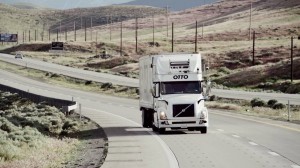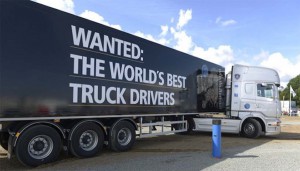If you’ve spend any time on the freeway lately you’ve likely seen the signs on the back of some semi-trucks: “Drivers Wanted.” Indeed, the trucking industry is expected to come up about 50,000 drivers short this year.
If anything, the shortage only appears to be getting worse, according to the American Trucking Association which has issued a new report warning of what it called a “significant tightening of the driver market.” In fact, shippers may get less than half of the roughly 90,000 new drivers they need this year to meet growing demand.
Once seen as a well-paying road to a middle-class lifestyle, the job is more often viewed today as low-paying, tedious and risky. Worse, millennials may be questioning the long-term potential of a career behind the wheel as they read stories revealing the industry’s plans to replace human drivers as soon as possible with self-driving trucks that not only don’t draw paychecks but which can operate 24/7.
“Fleets are…suffering from a lack of qualified drivers,” said Bob Costello, the chief economist of the American Trucking Associations. “It remains a serious concern for our industry, for the supply chain and for the economy at large.”
Industry data indicate 10.73 billion tons of freight will be moved by truck this year, more than two-thirds of all cargo shipped in the U.S. And a separate study released by the ATA in July forecast that the amount of goods hauled by trucks will grow a compounded 3% annually over the next five years.
The ATA estimates the industry needs to hire “roughly” 90,000 new drivers a year to meet the growing demand for over-the-road freight hauling. But there’s expected to be a 50,000 driver shortage this year, up from 36,500 in 2016. And the latest ATA report warns that unless the industry can find a way to make the job more appealing it could be 174,000 drivers short by 2026.
“While the shortage is a persistent issue in our industry, motor carriers are constantly working to address it,” Costello said. “We already see fleets raising pay and offering other incentives to attract drivers. Fleets are also doing more to improve the lifestyle and image of the truck driver.
The industry also has been trying to draw in more female drivers. Women currently account for barely 5% of American truckers, according to industry data.
(Tesla wants to plug into heavy-duty truck market with electric semi. Click Here for more.)
Trucking companies are also pressing for help from state and federal regulators. They recently convinced Washington to ease back on stricter rules limiting the number of hours a driver could spend on the road, a measure proponents said would reduce fatigue-related crashes – and reduce driver stress. The ATA also would like to see the feds take steps to get returning veterans to get into trucking, while it wants states to reduce driver age “as part of a graduated licensing system.”
Trucking is still a way for many Americans to step up, especially those with minimal educations and skills who might have lost jobs at American factories in recent years. One survey of drivers found about 17% did not even have a high school diploma.
There are always transients, those who simply need to find a paycheck until they find another job, or who don’t even think about careers. But a growing challenge for the trucking industry is getting young people to see the job as a career. And for many of those who would be starting out in the late teens or early 20s, it’s a serious question as to just how long a career they might have.
A year ago this week a truck rolled into history as it traveled from a Colorado brewing plant to a warehouse 120 miles away carrying 45,000 cans of Budweiser beer. The early morning run was done using a truck developed by a start-up called Otto, now an Uber subsidiary. Though there was a specialist seated in the truck’s sleeper berth to monitor things along the way, there was no driver behind the wheel.
(For more on that historic drive, Click Here.)
The ultimate goal for many freight-haulers is to take humans out of the truck entirely. Proponents cite a wide range of advantages. For one thing, no driver shortages. And no driver paychecks. There are potential safety advantages, at least if autonomous technology proves up to current claims. Such trucks would face no limits on how long they could operate on a shift. And advocates say driverless trucks could platoon, operating almost bumper-to-bumper, squeezing more vehicles onto existing roads while also improving aerodynamics – which translates into better fuel economy.
Several companies, including Ford and Tesla, are hoping to have driverless light, medium and even heavy-duty trucks ready by the middle of the coming decade. If they prove safe and effective there could be a rush to replace today’s human-operated rigs. And that would be a surefire way to overcome the worsening driver shortage. But until that happens, the truck industry appears likely to find itself struggling to find enough manpower to keep that growing tonnage of freight moving.
(Brown goes green. Click Here to see how UPS and other truck fleets are going for electric and hydrogen alternatives.)




Google the video on you tube called “Mind Your Loan Business” from the Dan Rather Investigation on truck driver training that exploits desperate people and ask yourself if this article is part of the problem for people in Detroit.